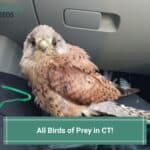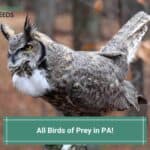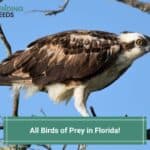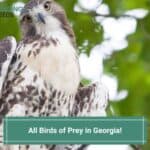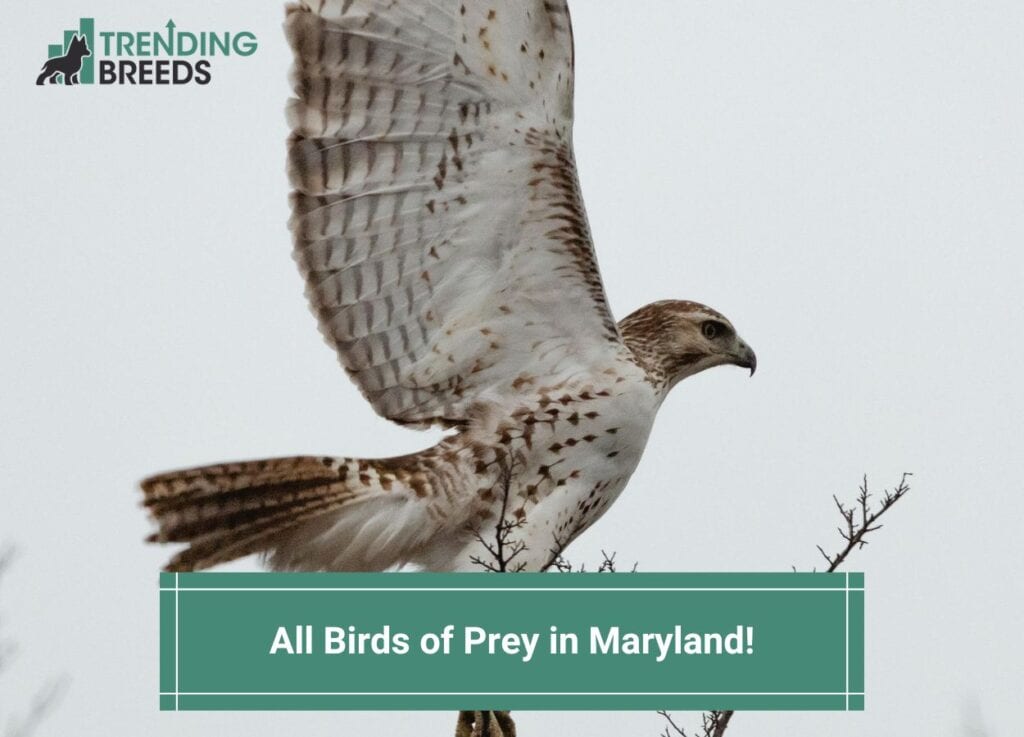
Maryland, a Mid-Atlantic State, is the ninth smallest state in the United States.
Spread over just 9,700 square miles of land, Maryland is home to many majestic predatory birds, including various species of Hawks, Owls, Falcons, and Vultures.
In today’s article, we’ll discuss some exotic birds of prey in Maryland and will arm you with the knowledge to identify them via appearance and habitat.
Before you scroll further down this guide, check out these other animal-related articles: Best Labrador Breeders in Maryland and Best Cavapoo Breeders In Maryland.
Table of Contents
1. Cooper’s Hawk
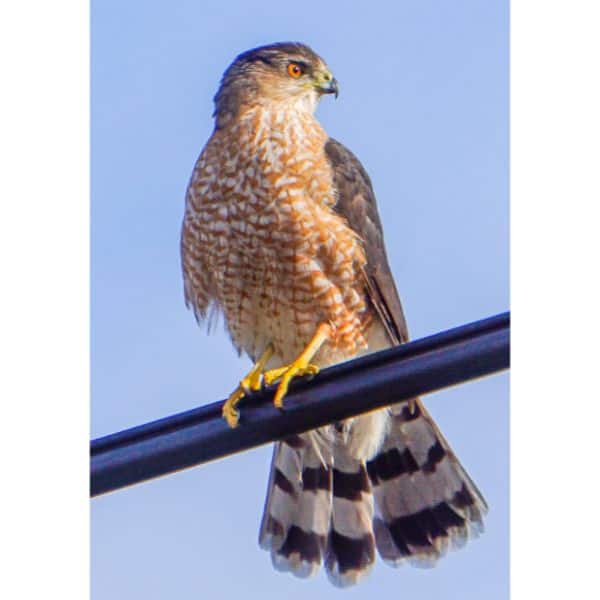
Cooper’s Hawk Characteristics:
- Scientific Name: Accipiter cooperii
- Size: 14.6-17.7 inches
- Weight: 0.49-1.5 lbs.
- Wingspan: 24.4-35.4 inches
- Lifespan: 12 years
- Conservational Status: Least Concern
The Cooper’s Hawk can be spotted year-round in Maryland and resembles the Sharp-shinned Hawk significantly.
Both birds of prey have relatively steely blue-gray feathers, little black caps on their heads, and rufous-colored chests.
Moreover, these two raptors share hunting tactics and inhabit the woodlands of Maryland.
However, their size sets them apart – the Cooper’s Hawk is comparatively larger than the Sharp-shinned Hawk.
As mentioned, Cooper’s Hawks are common in the woodlands, on the edge of fields, and also frequent backyards.
They have remarkable flying agility and often use high-speed chases to grab songbirds around feeding stations.
These raptors prey on European Starlings, Red-winged Blackbirds, and Mourning Doves.
2. Great-Horned Owl
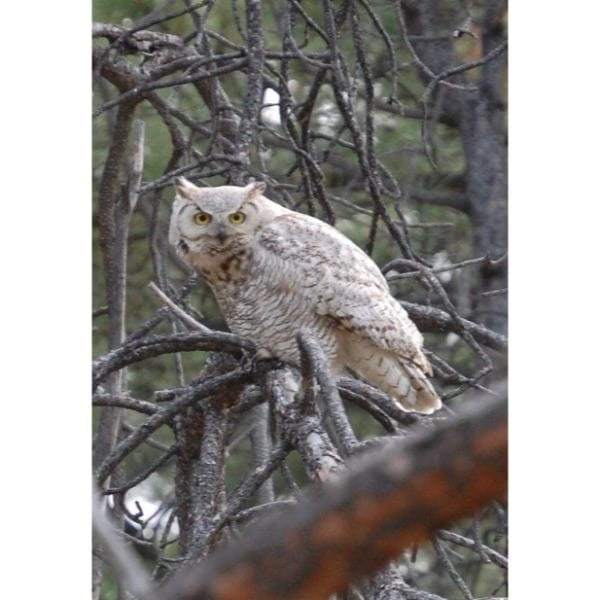
Great-horned Owl Characteristics:
- Scientific Name: Bubo virginianus
- Size: 18.1-24.8 inches
- Weight: 2.01-5.51 lbs.
- Wingspan: 39.8-57.1 inches
- Lifespan: 20-30 years
- Conservational Status: Least Concern
Great-horned Owls are the largest and most common birds of prey in Maryland.
They are named after the distinct-looking ear tufts resembling two large horns on their head.
These birds of prey are mortal enemies of Red-tailed Hawks since they share diverse habitats, are found all year round, and enjoy similar diets.
However, they differ in hunting styles.
These raptors feature an orangish face, bright yellow eyes, and black and white contrasting stripes resembling those of a tiger.
To aid camouflage, they sport horizontal bars on their belly, which look like tree branches from below, and mottles of tree-colored feathers on their upper side that look like leaves when seen from above.
Regarding habitat, Great-horned Owls are commonly seen in swamps, forests, tundras, deserts, tropical rainforests, open fields, and urban and suburban cities and parks.
Due to their weak sense of smell as compared to most predators, they are the only birds that routinely hunt and eat skunks!
3. Sharp-Shinned Hawk
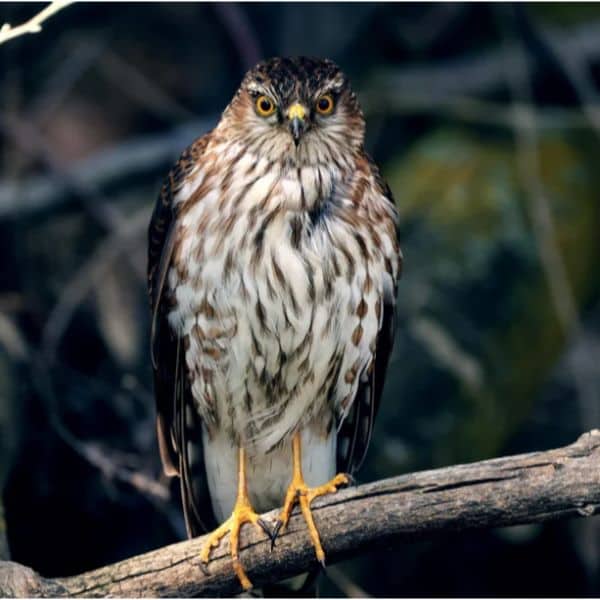
Sharp-shinned Hawk Characteristics:
- Scientific Name: Accipiter striatus
- Size: 9.4-13.4 inches
- Weight: 0.19-0.48 lbs.
- Wingspan: 16.9-22.1 inches
- Lifespan: 5 years
- Conservational Status: Least Concern
As mentioned with Cooper’s Hawk, the Sharp-shinned Hawk is the other most common Hawk found in Maryland’s northeastern forests.
These relatively small birds have earned this name because of their lightning speeds and unique acrobatic flying and hunting skills.
Sharp-shinned Hawks have short, rounded wings and a comparatively long tail.
They feature orange bars on their upper chest that slowly fade towards the belly and a bluish-gray back and wings.
Moreover, these raptors stand out because of their orange-feathered chest.
Sharp-shinned Hawks commonly inhabit forested regions of Maryland.
Like the Cooper’s Hawk, these birds also hang around bird feeders and prey on songbirds.
Their hunting style involves patiently and silently waiting for their prey and dashing out at full speed to chase them.
4. Peregrine Falcon
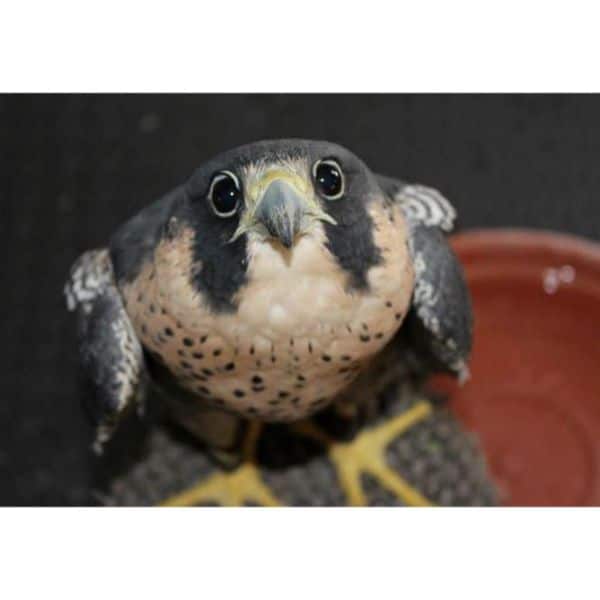
Peregrine Falcon Characteristics:
- Scientific Name: Falco peregrinus
- Size: 14.2-19.3 inches
- Weight: 1.17-3.53 lbs.
- Wingspan: 39.4-43.3 inches
- Lifespan: 15 years
- Conservational Status: Least Concern
There are more than 23,000 Peregrine Falcons spread all over the world except the Arctic.
These raptors flaunt slate grayish/bluish-black feathers on their back with slight barring. Their chests can be white to tan and feature thin, dark lines.
In the mid-20th century, Peregrine Falcons were almost eradicated from North America because of pesticide use; however, their populations have since increased, and they are thriving.
When Peregrine Falcons dive, they can attain up to 200 mph speeds. So, unlike the Cheetah, these raptors are the fastest animals on the planet!
They like perching on and around tall buildings and, hence, are commonly seen in urban areas.
Regarding eating habits, these birds are not picky and hunt anything they can catch, such as seagulls, ducks, songbirds, and pigeons.
5. Northern Goshawk
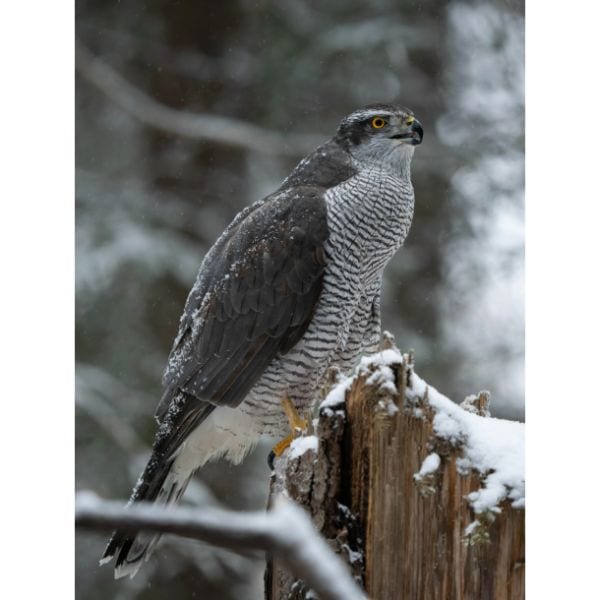
Northern Goshawk Characteristics:
- Scientific Name: Accipiter gentilis
- Size: 20.9-25.2 inches
- Weight: 1.39-3.01 lbs.
- Wingspan: 40.5-46.1 inches
- Lifespan: 11 years
- Conservational Status: Least Concern
Northern Goshawk, the larger, angrier, and fiercer relative of the Sharp-shinned and Cooper’s Hawk, is found in Maryland during winter.
These raptors are easily identified by their predominantly gray plumage, reddish or orangish eyes, gray barring on the chest to the belly, and thick white stripes over their eyes that resemble eyebrows.
Unlike their relative Hawks, Northern Goshawks prefer to stay hidden from civilization and are difficult to spot in the city and suburbs.
Their ideal habitat is dense forests, and they have also been reported to attack humans if they come too close to their nests.
Northern Goshawks are named after the Old English word ‘goose hawk’ because they prey mainly on other birds and smaller Hawks.
However, these birds of prey have a diverse diet that includes mammals, insects, reptiles, and occasionally carrion.
6. Golden Eagle
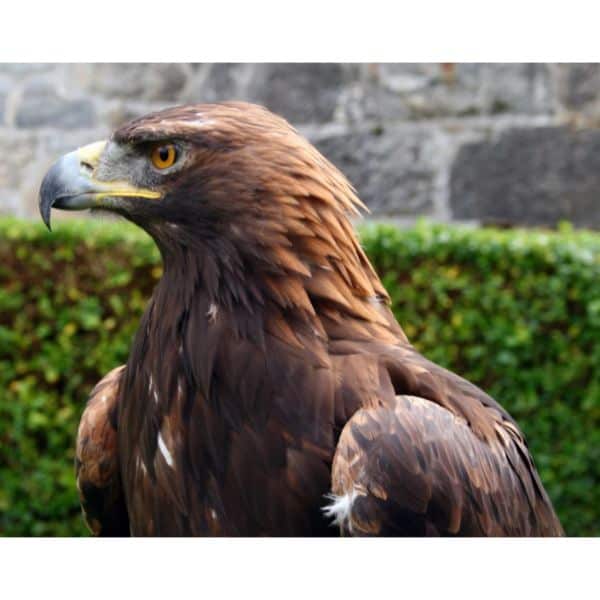
Golden Eagle Characteristics:
- Scientific Name: Aquila chrysaetos
- Size: 27.6-33.1 inches
- Weight: 6.61-13.5 lbs.
- Wingspan: 72.8-86.6 inches
- Lifespan: 30 years
- Conservational Status: Least Concern
The Golden Eagle is one of the largest birds of prey in Maryland and North America.
Although it is relatively scarce in Maryland, some migrate through the State and can be spotted during spring and fall.
These giant birds have dark brown plumage with golden feathers on their necks and backs – hence their name.
Golden Eagles are among the few raptors with feathers covering their legs and feet.
Extremely fast and agile hunters, these birds prefer to inhabit widespread open landscapes featuring high cliffs, hills, or mountains from where they can perch and spot prey.
Golden Eagles can also be seen in farmlands, grasslands, shrub lands, and coniferous woodlands.
They mainly feed on medium-sized mammals such as hares, rabbits, ground squirrels, marmots, and prairie dogs.
However, these raptors occasionally hunt large prey, including seals, deer, mountain goats, badgers, and coyotes.
7. Turkey Vulture
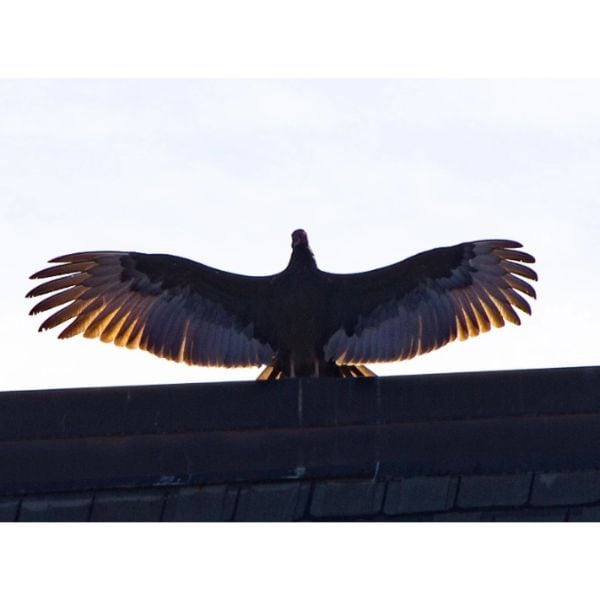
Turkey Vulture Characteristics:
- Scientific Name: Cathartes aura
- Size: 25-32 inches
- Weight: 2.0-5.0 lbs.
- Wingspan: 63-72 inches
- Lifespan: 15 years
- Conservational Status: Least Concern
Also called the Turkey Buzzard, the Turkey Vulture is extremely common in Maryland and the most abundant vulture in the United States.
As their name suggests, they resemble a Wild Turkey with their all-black plumage, bald red head, pinkish bill, and beak shape.
To spot a Turkey Vulture in the sky, look for a large bird soaring in wobbly circles with raised wings resembling the letter ‘V.’
It’s believed that this flying maneuver helps these raptors glide close to the ground to smell and spot food.
In addition, Turkey Vultures have an incredible sense of smell and can spot the scent of dead animals 8 miles away!
Turkey Vultures largely inhabit Maryland’s dense forests and woodlands.
Since they prefer to feed on fresh food instead of carrion, these birds of prey try to reach injured or dead animals as quickly as possible.
8. Barn Owl
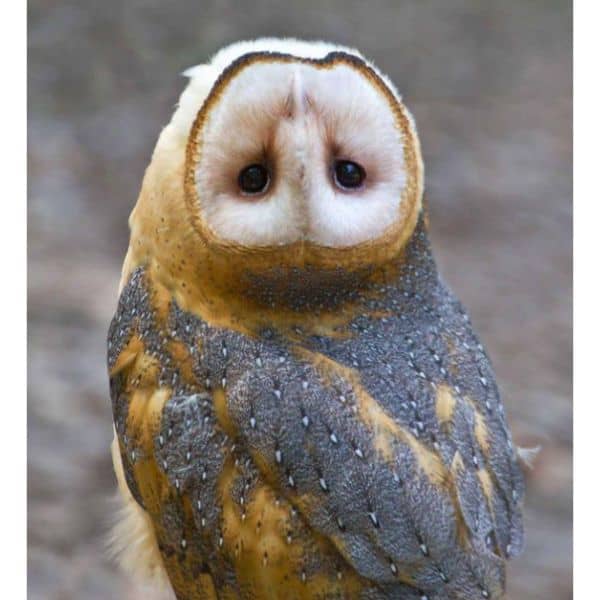
Barn Owl Characteristics:
- Scientific Name: TytoAlba
- Size: 12.6-15.8 inches
- Weight: 0.88-1.54 lbs.
- Wingspan: 39.4-49.2 inches
- Lifespan: 15 years
- Conservational Status: Least Concern
The Barn Owl goes by many names – the Church Owl, the Monkey-faced Owl, and the Ghost Owl.
This raptor is easily distinguished by its black, sandy plumage and heart-shaped face.
The latter efficiently directs sound to the Owl’s ears and contributes to their amazing hunting abilities.
Barn Owls are very common in Maryland and Northern America and are the most widely distributed birds, with 46 subspecies worldwide.
As their name suggests, these Owls inhabit man-made structures such as backyards, barns, churches, farms, and frequent rural countryside areas.
Like most Owls, Barn Owls are nocturnal.
With their exceptional sense of hearing and low-light sight, these raptors meticulously can detect the sound of prey from underneath snow, bushes, and thickets.
They hunt small mammals and swallow their prey whole while regurgitating the parts they don’t need.
9. Broad-Winged Hawk
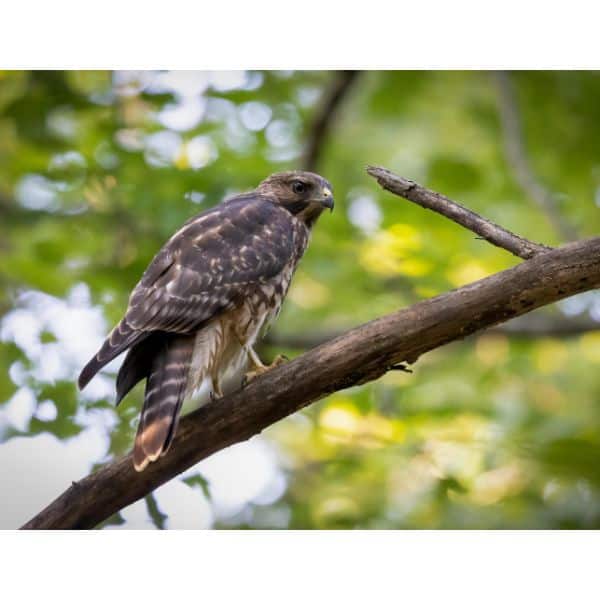
Broad-winged Hawk Characteristics:
- Scientific Name: Buteo platypterus
- Size: 13.4-17.3 inches
- Weight: 0.58-1.24 lbs.
- Wingspan: 31.9-39.4 inches
- Lifespan: 12 years
- Conservational Status: Least Concern
With short and stocky bodies, Broad-winged Hawks are relatively smaller Hawks that flaunt brown chests and heads, lined underparts and black and white bars on their tails.
They are distinguished by their short tails and distinctive broad wings with pointy tips when in flight.
Broad-winged Hawks spend the summers in Maryland and migrate in the thousands to Central and South America for the winter.
Although they are fairly common in the State, they are somewhat difficult to spot since they prefer residing deep in the woods, away from humans and the urban population.
Broad-winged Hawks inhabit and nest in forests, preferably near water bodies.
Their diet includes various small mammals and amphibians, such as toads, frogs, and insects.
10. Eastern Screech-Owl
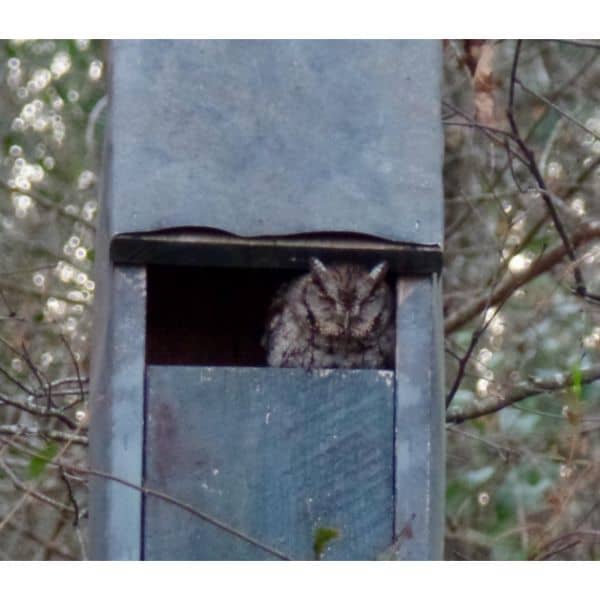
Eastern Screech-Owl Characteristics:
- Scientific Name: Megascops asio
- Size: 6.3-9.8 inches
- Weight: 0.26-0.54 lbs.
- Wingspan: 18.9-24.0 inches
- Lifespan: 8-10 years
- Conservational Status: Least Concern
Eastern Screech-Owls are year-round residents of Maryland. These owls come in two colors, gray and red; however, almost one-third of all individuals are red.
They have a spotted head, a small beak hidden within their fluffed, lined plumage, and black-rimmed pale-yellow eyes.
Despite their name, Eastern Screech-Owls don’t have a ‘screeching’ hoot.
They make different sounds, among which the even-pitched trill known as a tremolo is very well-known.
The latter lasts about three to six seconds and is used by pairs to stay in touch.
Although predators, Eastern Screech-Owls are quite fond of humans and often visit backyards with nesting boxes and bird baths.
They inhabit woodlands and dense forests close to water bodies. Despite being relatively small, these birds of prey feed on rodents, songbirds, and insects.
11. Bald Eagle
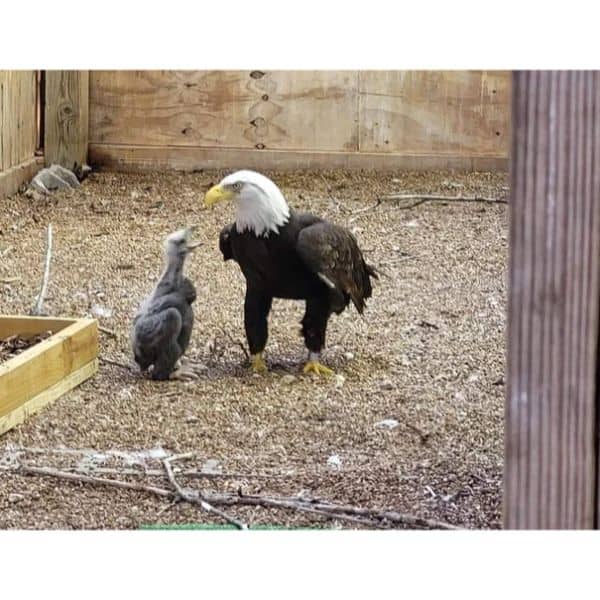
Bald Eagle Characteristics:
- Scientific Name: Haliaeetus leucocephalus
- Size: 27.9-37.8 inches
- Weight: 6.61-13.9 lbs.
- Wingspan: 80.3 inches
- Lifespan: 20-30 years
- Conservational Status: Least Concern
The Bald Eagle – the national bird of the United States since 1782 – is possibly the most easily recognizable predatory bird in Maryland.
Bald Eagles have distinctive yellow beaks and a patch of shiny white hair on their heads.
However, they gain this appearance once they’re five years old, so it takes a lot of experience to correctly identify this bird of prey when it is young.
Approximately the same size as Golden Eagles, these raptors have no bald spots.
Their name is derived from the Old English word ‘piebald,’ meaning ‘white patch,’ and refers to their white heads.
Regarding habitat, Bald Eagles prefer to occupy forests near large water bodies such as marshes, coasts, lakes, and rivers.
This facilitates their access to fish, which is their primary prey. Although Bald Eagles are phenomenal hunters, they usually prefer stealing food from other animals.
12. Osprey
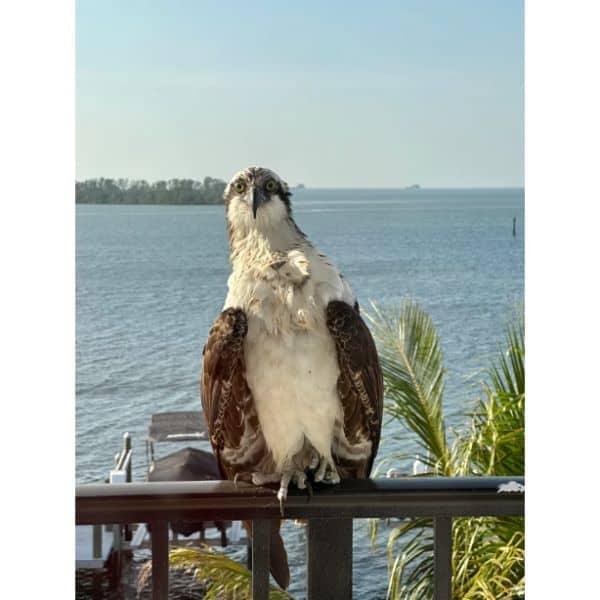
Osprey Characteristics:
- Scientific Name: Pandion haliaetus
- Size: 20-25.5 inches
- Weight: 3.0-4.4 lbs.
- Wingspan: 59-71 inches
- Lifespan: 7-10 years
- Conservational Status: Least Concern
Ospreys are usually mistaken for Hawks, but they’re distinctive birds with their own family (Pandionidae).
These raptors have brown upper sides and white undersides and are relatively whiter than most birds of prey.
Their wings are predominantly white from underneath, with prominent dark patches on the wrists.
They have white heads with a wide brown stripe running through their eyes.
Like Bald Eagles, Ospreys feed principally on fish; however, they are opportunistic about the species of fish they hunt.
To help them catch their prey, they have strong, curved talons that intersect when fully closed. This ideal design helps these birds hold on to big, slippery fish!
To easily acquire prey, Ospreys choose habitats near water bodies.
That’s why they are often spotted quarreling for fish with the Bald Eagle and occasionally stealing its hunt.
13. Red-Shouldered Hawk
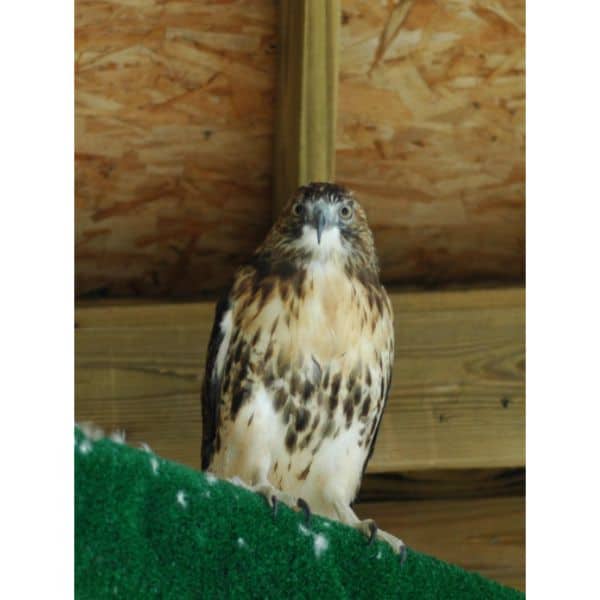
Red-shouldered Hawk Characteristics:
- Scientific Name: Buteo lineatus
- Size: 16.9-24.0 inches
- Weight: 1.71-1.07 lbs.
- Wingspan: 37.0-43.7 inches
- Lifespan: 10-20 years
- Conservational Status: Least Concern
Last but not least on our list of birds of prey in Maryland is the Red-shouldered Hawk.
Found in Maryland all year old, these Hawks are identified by the rusty red feathers on their shoulders.
There is significant white barring on their breasts that extends down to their bellies and goes all the way down to their strongly banded tail.
Their back and wings have dark, almost black feathers and significantly wide wingspans.
Red-shouldered Hawks inhabit and hunt in dense forests, particularly wetlands and flooded areas.
They have also been spotted in suburban areas residing on tall buildings.
These raptors have a unique hunting style and mostly rush at their prey head-on.
Typical of most Hawks, Red-shouldered Hawks eat mainly small birds and mammals, reptiles, and amphibians.
All Birds of Prey in Maryland
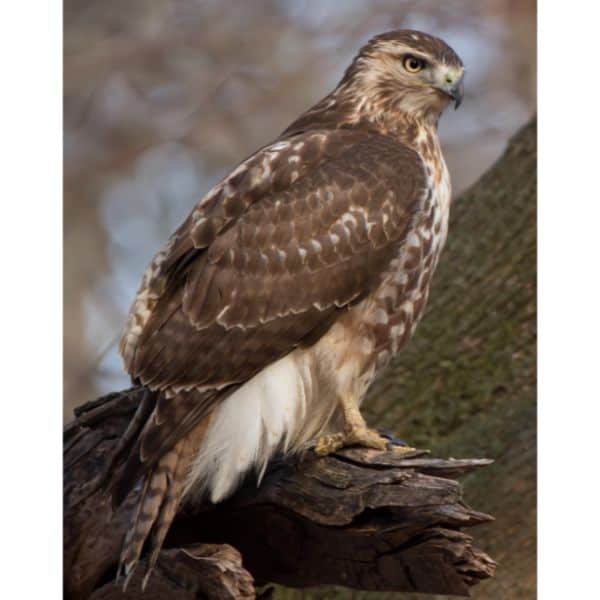
Maryland has many birds of prey, some migratory and others staying all year old.
Each predatory species has its own exotic appearance, from Hawks to Eagles to Owls to Falcons.
In today’s guide, we’ve highlighted 15 common birds of prey you can spot in Maryland.
So, the next time you visit or plan a hike, get your handy dandy birdwatching notebook ready and see how many raptors you can identify correctly!
If you find this guide, “All Birds of Prey in Maryland,” informative and helpful, you can check out these other bird-related articles from our team:
You can learn more about birds by watching “All 13 Birds of Prey & What Makes Them Incredible” down below:

